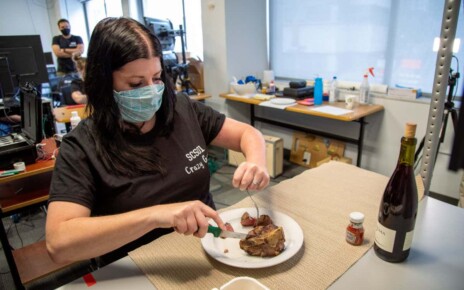[ad_1]

The Wendilgarda galapagensis spider sometimes spins a ‘water’ web
Darko Cotoras
An island spider decides which of its three kinds of webs to make depending on location and perhaps individual preferences.
Spiders usually make only one kind of web, but the Wendilgarda galapagensis spider – which lives exclusively on Cocos island, about 550 km off the western coast of Central America – can make three different webs.
Advertisement
High above ground it makes ‘aerial’ webs attached to nearby stems and leaves. Nearer to the ground it makes ‘land’ webs with long horizontal strands secured between branches and with a series of vertical strands anchored to the ground. Finally, over pools it makes ‘water’ webs that are a bit like the land webs, but with the vertical strands attached to the water surface itself.
Darko Cotoras at the California Academy of Sciences in San Francisco wondered whether this flexibility in web construction indicates the spider is undergoing speciation, splitting into three distinct species each with unique behaviours and exploiting a different food source. So with his colleagues he ran genomic analyses on 142 of the spiders.
To the team’s surprise, however, the results revealed that all the spiders belonged to the same species, says Cotoras. This means they have not genetically diversified since arriving on the newly formed volcanic island perhaps as long as two million years ago, when their ancestors were probably carried in by air currents.
The researchers then marked the two-millimetre-long spiders with drops of fingernail polish and moved them to different locations on the island to track their behaviour. For example, they took water-web-making spiders away from water sources and placed them nearby in high bushes. Again, the researchers were surprised to see that the spiders often built a new web with the architecture suited to the new location.
“This level of individual differentiation in terms of architecture, construction behaviour, and microhabitat is unparalleled compared with other spiders,” says Cotoras.
The species probably developed such flexibility because it helps the tiny spiders thrive on such a small, isolated island, he says.
“It seems they adapt their behaviour to perform multiple roles, sort of like people do when they live in a small town as opposed to a big city,” Cotoras says.
That doesn’t mean the spiders necessarily like the idea of getting moved, however. In the experiment, Cotoras found that when some spiders were moved to a new microhabitat they promptly crawled back to the microhabitat they had been occupying before the experiment.
“They might have intrinsic preferences, sort of like humans do, and maybe a preferred kind of web,” he says.
Journal reference: Proceedings of the Royal Society B, DOI: 10.1098/rspb.2020.3138
More on these topics:
[ad_2]
Source link




